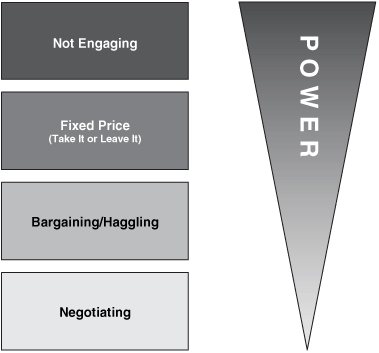Process of Exchange
In the earlier definition of negotiation, I used the phrase process of exchange. In the varied ways we exchange currencies for goods and services, negotiation is only one of several processes of exchange. Figure 1.2 represents a hierarchy of the exchange processes based on level of power.
Figure 1.2. Process of Exchange and Power

At the top of the power scale, the not engaging strategy involves a refusal to even open the negotiation. Consider the example of a person who owns a beautiful art object with so much value or meaning to the individual that it’s not on the market. Along comes a buyer willing to pay such an outrageous price that the other party is stunned into at least consideration of selling. However, the power lies with the person who owns the object and does not want to sell.
Consider the folksy story of the driver who comes across a beautiful seaside home. The home owner is working in her garden as the potential buyer approaches.
| POTENTIAL BUYER: | Good afternoon. What a beautiful house you have here. |
| HOME OWNER: | Why thank you, it’s been in my family for generations. |
| POTENTIAL BUYER: | Is it for sale? |
| HOME OWNER: | No. There’s no way I would ever sell this house. |
| POTENTIAL BUYER: | I would give you $500,000 for it. (Close to market value.) |
| HOME OWNER: | Perhaps you didn’t hear me the first time. It’s not for sale! |
| POTENTIAL BUYER: | I could increase my offer to $1 million. ... |
Get Practical Negotiating: Tools, Tactics & Techniques now with the O’Reilly learning platform.
O’Reilly members experience books, live events, courses curated by job role, and more from O’Reilly and nearly 200 top publishers.

